In the opening scene of My Name Is Gulpilil (Molly Reynolds, 2021), the documentary’s 67-year-old namesake and protagonist, David Gulpilil, walks along a red dirt track in a pastoral landscape, following a meandering emu. As the sound of thunder signals an approaching storm, he turns around, makes eye contact with the viewer and walks slowly back towards the camera. The emu follows. Each of the actor’s steps is steady and measured, if perhaps laboured. While still a commanding presence in his black akubra hat and mustard jacket, this frail and ageing man is quite different to the striking icon of Australian cinema we’ve been used to seeing on our screens.
The next scene presents a closer view of our protagonist as he sits, tired and weak, in a hospital recliner receiving treatment for stage 4 lung cancer. Gulpilil was given months to live when diagnosed in 2017, but remains alive thanks to what he calls ‘white man’s medicine’ received in his current home of Murray Bridge, South Australia. The film cuts to footage of his first screen role in Walkabout (Nicolas Roeg, 1971). In this close-up shot, tears fall on the cheeks of a teenage Gulpilil as he stares intensely down the barrel of the camera. The montage that follows brings together further clips from his oeuvre that transition him from fearless youth to stoical elderly man.
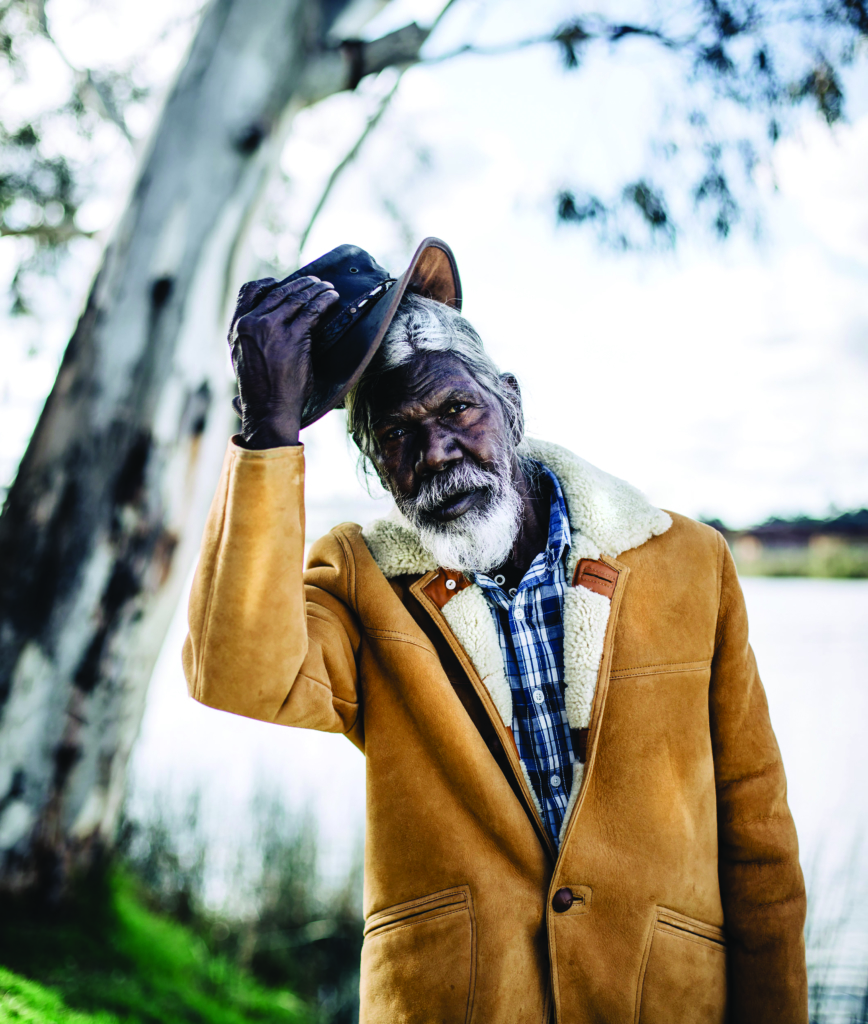
My Name Is Gulpilil is a gentle but powerful documentary that captures the actor’s journey towards death while also re-examining his life’s work. Reynolds encourages Gulpilil to tell his story in direct address; it is he and only he who speaks about his life, as indicated in his early statement, ‘This is my story of my story.’ Over the course of 100 minutes, the viewer is presented with material that not only explores Gulpilil’s role as a national storyteller, but also offers insight into his life as a dancer, painter, singer and fully initiated Yolngu man who continues to engage with his culture, despite his current distance from his country. Scenes unfold slowly: we see Gulpilil get dressed, take his medication and meander down his driveway to collect his mail. This is an intimate portrayal of a man whose legacy looms large.
Born into Yolngu culture in north-east Arnhem Land and raised away from the influence of white Australia, Gulpilil was initiated into the Mandhalpuyngu tribal group. He later attended a mission school at Maningrida, where he adopted the first name ‘David’. It was here that he was ‘discovered’ by the scouting UK filmmaker Roeg, who sought an accomplished young hunter, tracker and ceremonial dancer to cast in his film. Following Gulpilil’s induction into the world of moviemaking (and the English language) as an actor in Walkabout, the charismatic performer was thrust onto the global stage, where he walked the red carpet at high-profile festival events and mingled with celebrities such as Bruce Lee, John Lennon and Bob Marley. A string of memorable performances in commercially successful and/or critically acclaimed films – such as Storm Boy (Henri Safran, 1976), The Last Wave (Peter Weir, 1977), Crocodile Dundee (Peter Faiman, 1986), Until the End of the World (Wim Wenders, 1991) and Rabbit-Proof Fence (Phillip Noyce, 2002) – followed.
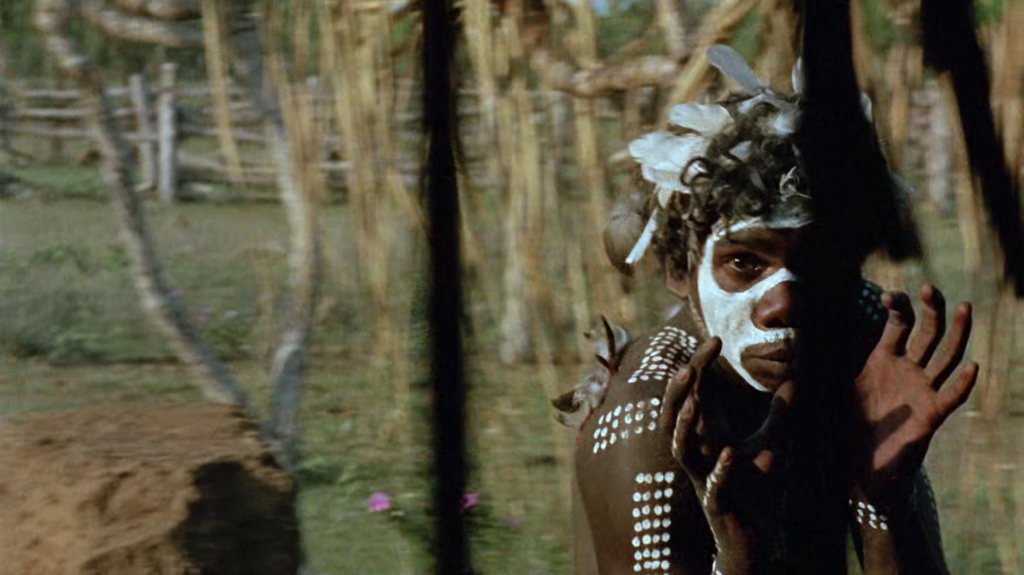
Particularly notable are Gulpilil’s collaborations with European-born auteur directors such as Roeg, Wenders and the Australian-based Rolf de Heer (the last of whom also serves as a co-producer of My Name Is Gulpilil). De Heer first cast the actor in the 2002 film The Tracker, a performance that Gulpilil describes as ‘his first leading role’, and one that garnered him an AFI Award. A series of collaborations followed, including Ten Canoes (co-directed with Peter Djigirr, and the first film exclusively told in Aboriginal languages) in 2006 and Charlie’s Country in 2013 – films Gulpilil played a pivotal role in helping to create. According to scholar Lisa French, these collaborations enabled Gulpilil to ‘amplify the marginalised Aboriginal voice’,[1]Lisa French, ‘David Gulpilil, Aboriginal Humour and Australian Cinema’, Studies in Australasian Cinema, vol. 8, no. 1, 2014, p. 39. See also Marcia Langton, ‘Aboriginal Art and Film: The Politics of Representation’, Race & Class, vol. 35, no. 4, 1994, pp. 89–106. allowing for what Yiman academic Marcia Langton has described as ‘intercultural dialogue’.[2]Langton, ibid. Speaking about his film work in the documentary, Gulpilil comments, ‘I like to make a film. It’s a history. I like it because you can’t rub it out.’ In this sense, the actor has been integral in the capturing of Aboriginal history and subjective experience on screen, which has in turn resulted in greater public understanding of Australia’s First Nations people.
Hard cuts bring together past and present as a means to visualise Gulpilil’s reflections. In these sequences, the actor is both immortalised on screen and clearly mortal as a performer nearing the end of his life.
Certainly, while watching My Name Is Gulpilil, the viewer may find themselves contemplating the evolving representation of Aboriginal people in Australian cinema. In his first screen role as the ‘black boy’ in Walkabout (the first Australian film to feature an Aboriginal actor in a major role since Charles Chauvel’s 1955 feature Jedda), Gulpilil embodies the exotic or mystical ‘Other’, a ‘noble savage’ who seeks to help abandoned British siblings. Years later, in Crocodile Dundee, the actor uses humour to subvert this type of representation, an approach that also features in his later works; while, in the documentary, Reynolds includes two key scenes from feature films The Tracker and The Proposition (John Hillcoat, 2005) where Gulpilil’s character uses laughter to undercut the authority of white oppressors. French suggests that ‘in these instances, the insertion of humour offers a new, more human understanding of relations between first Australians and their colonisers’.[3]French, op. cit., p. 38. The documentary also features rich material from Charlie’s Country, another film in which Gulpilil takes the lead role, this time exploring the place of Aboriginal culture in contemporary Australia. Taken as a whole, this material backs up scholars Felicity Collins and Therese Davis’ claim that
Gulpilil’s performances since Walkabout have rung the changes in cinema’s stock figure of the Australian Aboriginal, to the extent that Gulpilil stands for a type of national character, story or landscape that is specific, local, and non-transferably Australian.[4]Felicity Collins & Therese Davis, Australian Cinema After Mabo, Cambridge University Press, Cambridge & New York, 2004, p. 25.
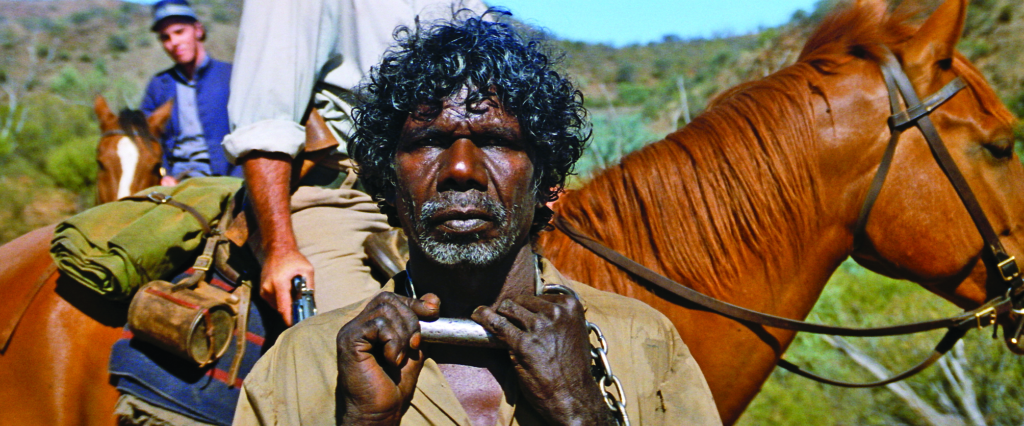
Reynolds weaves together these dramatic scenes with archival footage and Gulpilil’s present-day reflections. A key stylistic approach sees the ageing actor revisiting sites of film productions to reflect upon his performances. Hard cuts bring together past and present as a means to visualise these reflections, with the landscape providing a vehicle to access memories of his film work. In these sequences, Gulpilil is both immortalised on screen (as his younger self) and clearly mortal as a performer nearing the end of his life.
Less familiar to the cinephile will be footage from the actor’s 2004 Adelaide Festival one-man show Gulpilil, co-written with Reg Cribb and directed by Neil Armfield. The documentary on several occasions cuts to footage from this show, in which Gulpilil sports a white shirt and evening suit and candidly describes his encounters with the European world, including lunch with the British Royal Family. His self-deprecating humour is further highlighted in these lively sequences that interrogate his experiences of fame and navigating mainstream Western culture.
On the subject of bridging two cultures, the documentary does not shy away from tackling Gulpilil’s past problems with substance abuse. In archival interview footage, a young version of the actor states, ‘I live in two worlds: the Western world and the tribal world. I cope okay.’ However, later sequences evidence the difficulties that have manifested over time. Gulpilil’s problems with alcohol have seen him arrested several times and jailed for an act of domestic violence in 2010.[5]See ‘David Gulpilil Jailed for Assaulting Wife’, The Sydney Morning Herald, 22 September 2011, <https://www.smh.com.au/national/david-gulpilil-jailed-for-assaulting-wife-20110922-1kmx2.html>, accessed 4 May 2021. Reynolds juxtaposes blurry footage of Gulpilil walking the red carpet and winning an award at a recent Australian film industry event with his descriptions of destructive periods of his life spent ‘living in the long grass’ in the Northern Territory, highlighting the distance of one world from the other. In another sequence, a now present-day Gulpilil stands alone in a brightly lit hospital corridor, slightly hunched over as audio grabs of news stories reporting on his past arrests and criminal charges reverberate around him. ‘I’m a drug [addict] and alcoholic – me,’ he states, staring candidly at the viewer. ‘I’ve been locked up in Darwin many times.’ A further archival behind-the-scenes clip from a film production sees his behaviour causing conflict on set. Reynolds has spoken of her own tensions with Gulpilil during their work together, but also observes,
I think David’s experience of whitefellas is they don’t stay the course. The whitefella culture is a very difficult one for most blackfellas to trust. I had to earn my keep and I like to think I did. [6]Molly Reynolds, quoted in Farrin Foster, ‘David Gulpilil’s Final Story’, InReview, 3 March 2021, <https://indaily.com.au/inreview/adelaide-festival/2021/03/03/david-gulpilils-final-story/>, accessed 4 May 2021.
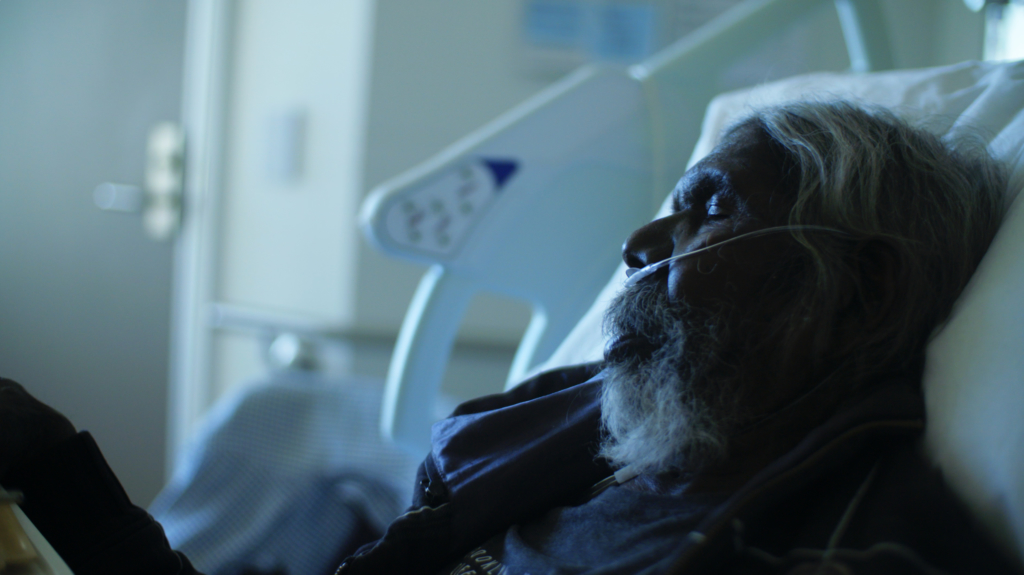
A shot of Gulpilil dozing in a chair at home brings this sequence to an end. ‘Old man, you’re a bit tired today,’ observes his off-screen carer, Mary Hood. ‘Yeah,’ replies Gulpilil, appearing world-weary and defeated. It is clear that living between two worlds has taken a heavy toll.
Perhaps the most touching moments in the documentary capture the protagonist’s interaction with visiting family members. Tears are shed on their arrival and departure, the implication being that this may be the last time that they see Gulpilil alive. The family talk about preparations for his funeral, a complex task that requires the participation of many in his ancestral lands. While Gulpilil expresses a desire to return to his country prior to his death, it seems unlikely that he will be able to do so. One shot of the documentary sees the camera placed outside the bedroom of his Murray Bridge home as he stands looking out of the window, a body enclosed and trapped by illness; another features a topographic perspective of Gulpilil’s suburban neighbourhood. This god’s-eye shot of a tidy housing estate, contrasted with the relatively uncolonised Northern Territory landscapes that also feature in the film, further reminds us of the distance between these two places, and the difficulty of being separated from country while gravely ill.
Regardless of this distance, Gulpilil continues to engage in cultural practices such as painting and hair twisting (the latter a technique of making string for use in ceremonial headbands and armbands that is unique to his two clans). Gulpilil seems keen to share this tradition with the viewer, describing how he learned the practice as a child and that now only he can teach it. He also speaks at length of the funeral traditions of his people, recalling his own father’s death. In this way, the documentary looks beyond Gulpilil’s film work to emphasise his status as a Yolngu elder and keeper of knowledge.
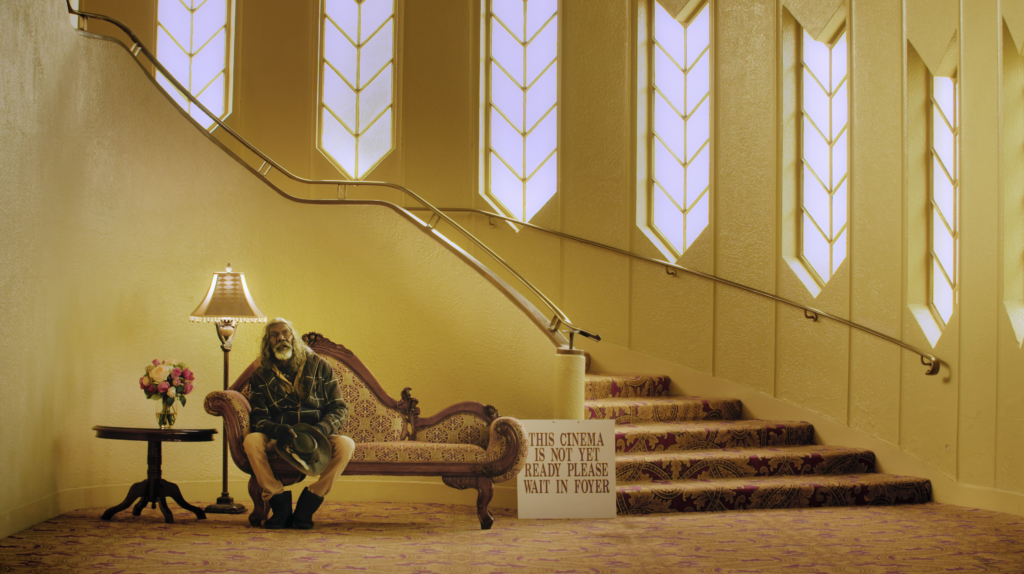
Bringing all of these elements together, My Name Is Gulpilil presents a portrait of a complex man who has profoundly influenced Australian cinema. His work as a storyteller is multifaceted and understated, as reflected in the many fictional and actuality clips included in the documentary. Speaking about his performance style, Gulpilil comments, ‘My acting is normal. I don’t have to pretend […] I just jump in and stand there and the camera sees me.’ This statement reflects the way that Gulpilil, the man, is implicated in each of his on-screen roles, as well as how his life has been shaped by the activity of filmmaking. Towards the end of the film, Reynolds’ celebration of his work and anticipation of his death are captured in a highly staged overhead shot of Gulpilil lying with his eyes closed in a coffin, surrounded by loose rolls of 35mm film. Contemplating this image, one might ponder the ways in which the actor’s death will mean not only the loss of a great performer, but also the loss of an entry point into a different way of seeing the world. My Name Is Gulpilil presents one last opportunity to journey with the actor – a worthy tribute that bids him a fond farewell.
Endnotes
| 1 | Lisa French, ‘David Gulpilil, Aboriginal Humour and Australian Cinema’, Studies in Australasian Cinema, vol. 8, no. 1, 2014, p. 39. See also Marcia Langton, ‘Aboriginal Art and Film: The Politics of Representation’, Race & Class, vol. 35, no. 4, 1994, pp. 89–106. |
|---|---|
| 2 | Langton, ibid. |
| 3 | French, op. cit., p. 38. |
| 4 | Felicity Collins & Therese Davis, Australian Cinema After Mabo, Cambridge University Press, Cambridge & New York, 2004, p. 25. |
| 5 | See ‘David Gulpilil Jailed for Assaulting Wife’, The Sydney Morning Herald, 22 September 2011, <https://www.smh.com.au/national/david-gulpilil-jailed-for-assaulting-wife-20110922-1kmx2.html>, accessed 4 May 2021. |
| 6 | Molly Reynolds, quoted in Farrin Foster, ‘David Gulpilil’s Final Story’, InReview, 3 March 2021, <https://indaily.com.au/inreview/adelaide-festival/2021/03/03/david-gulpilils-final-story/>, accessed 4 May 2021. |





